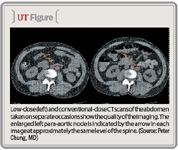Article
Low-dose computed tomography found viable in testicular cancer patients
Author(s):
Low-dose computed tomography scans reduce radiation exposure while maintaining diagnostic quality in patients with stage I testicular germ cell tumors being managed with surveillance following orchiectomy.
Toronto-Low-dose computed tomography scans reduce radiation exposure while maintaining diagnostic quality in patients with stage I testicular germ cell tumors being managed with surveillance following orchiectomy, report researchers from the University of Toronto's Princess Margaret Hospital.
Surveillance is a standard management option after radical orchiectomy, as most patients are young at diagnosis and almost all are cured of disease eventually. Surveillance for detection of relapse includes serial CT imaging of the abdomen (with or without imaging of the pelvis).
Conventional-dose CT scans are associated with radiation exposure of up to 20 mSv, but cumulative radiation exposure is a concern for young patients who may be at risk of carcinogenesis with high lifetime exposure.

Images were acquired using conventional-dose CT of the abdomen and pelvis and low-dose CT imaging consecutively at study entry. Surveillance was continued with low-dose CT alone if the image quality was adequate. Patients were taken out of the study if a relapse was detected by another means.
Retroperitoneal nodal relapse that was detected on nodal CT was confirmed with conventional-dose CT within 2 weeks. The CT images were evaluated by a single radiologist to compare nodal size at relapse between the two imaging techniques.

With a median follow-up of 26 months, there were 32 relapses, of which 30 had retroperitoneal nodal relapse. Of the 30 nodal relapses, 28 pairs of CT scans were assessed for nodal size.




